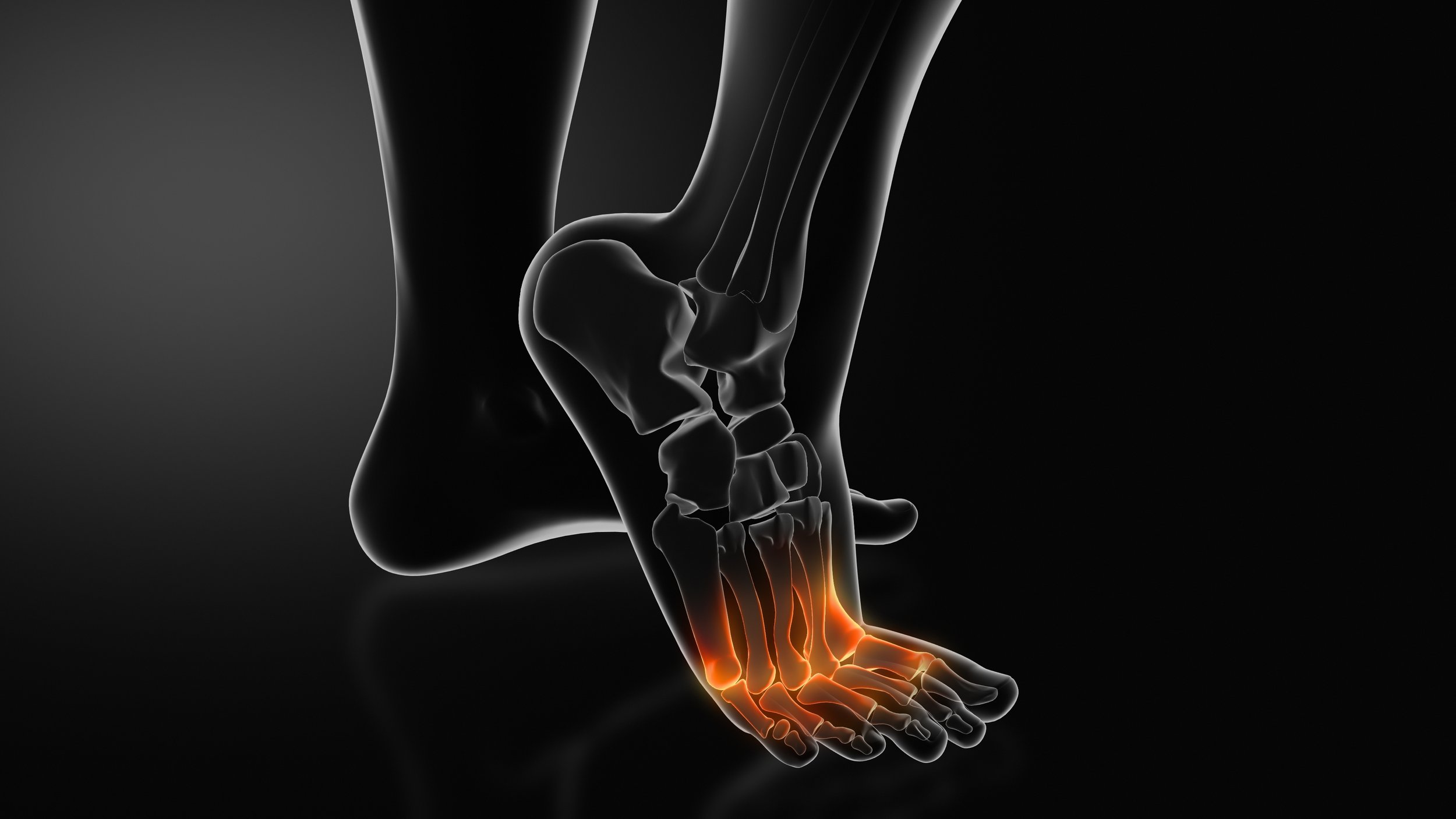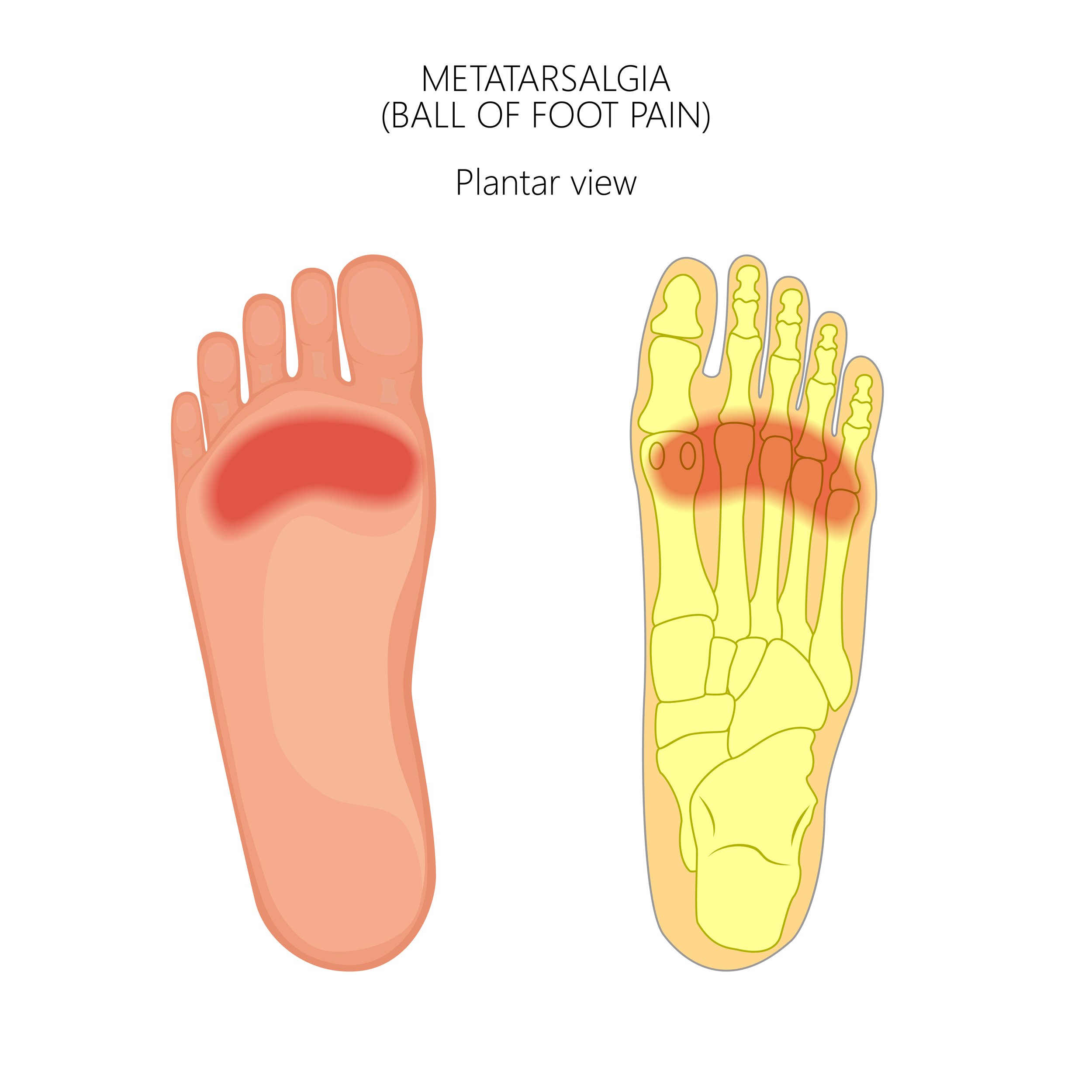What Is Metatarsalgia? A Podiatrist Explains Symptoms, Causes, and Treatments for this Cause of Foot Pain
In this blog, we’ll talk about something that’s a real pain.
It's called metatarsalgia, and it’s been a hot topic of late.
You may be unfamiliar with the term itself, but you may have experienced this issue firsthand (or foot, as it were).
At City Step Podiatry, we’re attuned to the needs of our patients. When this subject popped up several times recently, we took notice. We decided to front-load it on our content calendar, so we can explore everything you need to know about this cause of foot pain.
The name may be a mouthful, but it’s a very common foot condition that can cause serious pain and keep you from fully participating in your busy, active lifestyle.
Let’s explore everything you need to know about metatarsalgia.
What is metatarsalgia?
Beyond being quite the verbal mouthful—what IS metatarsalgia, anyway?!
In simple terms, metatarsalgia is pain and inflammation in the ball of your foot.
This means it affects the area on the bottom of your foot between your toes and your arches.
It takes its name from the bones of your feet. Your metatarsal bones are the five long bones that connect to the bones of your toes (your phalanges) and form the bulk of your forefoot.
These bones have several crucial functions, including anchoring your ability to:
Balance
Bear weight
And move (both your feet and, by extension, your body)
With those core functions laid out, it’s easy to see why your metatarsal bones, though small, are mighty. They also help to form the arches of your feet.
The pain and inflammation of metatarsalgia are most often felt where the bones of your toes (your phalanges) and the bones of your forefoot (your metatarsals) meet. This means metatarsalgia pain is usually localized just below the base of your toes, where they meet the rest of your feet.
This part of the bone is known as the metatarsal head.
But why does metatarsalgia happen? Now that you’re clear on the involved anatomy, let’s unpack some common causes of metatarsalgia.
What causes metatarsalgia?
Different issues and conditions can contribute to developing metatarsalgia.
What are the most common causes of metatarsalgia? Let’s break them down.
Causes of metatarsalgia include:
Activities and sports that put pressure on the forefoot—activities like running, jumping, and dancing can cause stress, strain, and even trauma to the balls of the feet, potentially leading to pain and inflammation.
Improperly fitting footwear—shoes that are too tight, too loose, or don’t offer your feet the support they need can contribute to metatarsalgia.
Foot anatomy—sometimes, the way your feet are built can contribute to metatarsalgia risks. Certain types of foot deformities can lead to metatarsalgia. Additionally, folks with high arches, hammertoes, and bunions are at higher risk for metatarsalgia, from the way these issues impact how the parts of the feet interface with one another.
Health conditions—inflammatory conditions like rheumatoid arthritis, gout, and Morton’s neuroma can contribute to metatarsalgia. Vascular or neurological conditions like Freiberg disease and Charcot-Marie-Tooth disease can also cause it.
Metabolic issues—obesity and diabetes can also impact your risk of developing metatarsalgia.
Sometimes, one of these issues leads to metatarsalgia. Other times, a combination of factors adds up to cause it.
Your podiatrist may assess and describe your metatarsalgia as being primary, secondary, or iatrogenic. These depend upon what’s causing your issue and will inform the course of treatment your podiatrist recommends.
Now that you know what causes metatarsalgia, let’s review its most common signs and symptoms so you know how to spot it in the wild.
Symptoms of metatarsalgia include:
Pain in the ball of the foot (the area between the base of your toes and the arch of your foot)
Metatarsalgia pain can often feel sharp, shooting, achy, or burning
Tingling or numbness in the toes
Inflammation can impact the nerves, which can lead to reduced sensation or a pins-and-needles feeling
Pain that worsens with activity and improves with rest
Metatarsalgia pain often gets worse with standing, walking, running, or stretching the feet. The pain may be especially intense if you’re barefoot or on a hard, unyielding surface
Sensation of a stone in your shoe
Feeling like you’re stepping on a pebble can be a sign of metatarsalgia. But this can also be a symptom of Morton’s neuroma. This is why assessment from a qualified medical professional is always important.
Next, let’s explore how metatarsalgia is treated, as well as ways you can prevent it.
How can I prevent and treat metatarsalgia?
Are you a “wait and see” person when it comes to aches and pains?
Metatarsalgia symptoms may improve on their own with rest and modified activity. But untreated metatarsalgia can also lead to other foot and ankle conditions.
Your body is a connected organism, so when you compensate for one issue, you risk causing other issues when your body must accommodate and adjust.
It’s usually better to be safe than sorry, and have your symptoms assessed by a qualified medical professional like a podiatrist.
It’s especially vital to see a medical expert right away if your symptoms:
Haven’t shown improvement in two weeks or have worsened
You have tingling or a loss of sensation in your affected foot
Your pain is seriously affecting your daily life and ability to participate in regular activities
You have diabetes (learn why people with diabetes need to take extra care of their feet)
Treating metatarsalgia
Your podiatrist will start by learning about your symptoms and when they started. They’ll perform a physical exam and may recommend an X-ray, ultrasound, or MRI to rule out other soft tissue conditions or a stress fracture.
Once your podiatrist has determined your pain is caused by metatarsalgia, they’ll likely approach treatment conservatively at first. Often, metatarsalgia responds to self-care measures. If not, more intensive approaches can be considered.
Treatment for metatarsalgia usually involves a combination of:
Rest
Icing
Use of compression
Elevating the affected foot
Performing stretches recommended by your podiatrist
Taking over-the-counter anti-inflammatories (like Advil)
Swapping your footwear for more supportive, better-fitting options
Wearing orthotic inserts
Popular podiatrist-recommended orthotic insert options include: Superfeet inserts and custom orthotics.
In the rare case your metatarsalgia doesn’t improve with these methods, surgery or injections may be a possibility to address the issue.
Preventing metatarsalgia
Let’s talk about strategies to keep metatarsalgia at bay.
The keys to preventing metatarsalgia lie in addressing its modifiable risk factors. These are the things you can control that contribute to metatarsalgia.
Many can be targeted with lifestyle changes and small tweaks to offer your feet the consistent support they need to stay healthy and pain-free.
Metatarsalgia prevention strategies include:
Avoid going barefoot or in stocking feet, especially on hard surfaces
Maintaining a healthy weight to reduce excess pressure, wear and tear on your feet
Pick footwear that supports your feet and fits well (your podiatrist can help you choose the right options for you. Check out our Footwear Focus blog series to discover some of Dr. Young’s favorite footwear brands!)
Add orthotic inserts to your shoes for added comfort, support, and stability
Remove any calluses to help relieve any added pressure on your feet (check out our helpful article that talks all about callus care for tips and guidance!)
Prevention also means listening to your body and its signals. This includes resting when you need to and acknowledging when you’re experiencing metatarsalgia symptoms.
Being proactive with taking breaks from sports and activities that can cause metatarsalgia is a great strategy to stop it in its tracks—while prioritizing your health and self-care in the process!
And remember: whenever you need expert support and personalized care, City Step Podiatry is here! We’ll help diagnose your foot issues and work with you to map out the ideal treatment plan for your foot and ankle health and wellness needs.
Book with us easily online, get answers to frequently asked insurance questions, and check out our menu of cutting-edge podiatry services.
City Step Podiatry is here for you! Reach out today to schedule your visit and treat your feet to the care they deserve.









